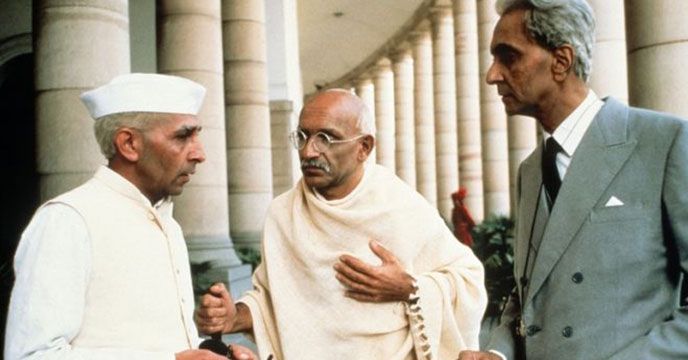On this day in 1869, #MahatmaGandhi was born in Porbandar, Gujarat.
In 1982, Richard Attenborough's film 'Gandhi' raked in eight Oscars. The film had an ensemble cast and crew, even in lesser roles. Many were already famous and many became legends in the years to come.
THREAD:
In 1982, Richard Attenborough's film 'Gandhi' raked in eight Oscars. The film had an ensemble cast and crew, even in lesser roles. Many were already famous and many became legends in the years to come.
THREAD:

In 1962, Motilal Kothari, while working for the Indian High Commission in London, asked Richard Attenborough whether he would direct a film on Gandhi. He got Mountbatten to have a word with Jawaharlal Nehru who agreed with the script. The film is dedicated to all three of them. 

Nehru's choice for the role of Gandhi was Alec Guinness. Peter Finch, Harvey Finney, Anthony Hopkins and even Dustin Hoffman were considered at one point of time. The role finally went to a certain Krishna Pandit Bhanji. Ben Kingsley, as he was better known, won an Oscar for it. 

Naseeruddin Shah and Smita Patil auditioned for the role of Mahatma and Kasturba. He wrote in his autobiography that the entire process was a hogwash for the Indian media as Kingsley was already selected by then. Shah eventually played the Mahatma in Kamal Hassan's 'Hey Ram’. 

Suresh Jindal was Associate Producer for Gandhi. Five years earlier, he had backed Satyajit Ray's 'Shatranj Ke Khiladi' which had Attenborough play the role of Outram. Jindal also roped in Pablo Bartholomew as a stills photographer for SKK. He reprised the role in Gandhi as well. 

Andrew Mollo drew costume sketches for Shatranj. His elder brother John shared an Academy Award for Best Costume Design with Bhanu Athaiya, incidentally the first Indian to get an Oscar. Pt. Ravi Shankar too was nominated for an Academy Award, in the Best Original Score category. 

Pandit Ravi Shankar actually sang for Gandhi in real life. When the Mahatma passed away in 1948, he took the third, seventh and sixth notes, 'ga', 'ni' and 'dha' in Indian terminology, as a tribute to Gandhi. The Raga Mohankauns he created then would be later used in the film. 

Some famous names in the cast of 'Gandhi' included the legendary John Gielgud as the viceroy Lord Irwin, Martin Sheen as Vince Walker, the New York Times' journalist Gandhi initially meets in South Africa and then during the Dandi March, though the character was fictionalized. 

Candice Bergen played the photojournalist Margaret Bourke-White for which she was nominated for a BAFTA. Edward Fox, whose most iconic role was the character of the assassin in The Day of the Jackal, had collaborated with Attenborough before. He played General Dyer in ‘Gandhi'. 

Geraldine James played Mrs Hudson in Guy Ritchie's Sherlock Holmes. She also appeared in The Girl With The Dragon Tattoo and most recently as Queen Mary in Downton Abbey. One of her earlier appearances was in Gandhi where she portrayed Madeleine Slade or Mira Behn as we know her. 

Daniel Day-Lewis, the only actor to win three Oscars for best actor, played a brief role of a street bully Colin who harasses Gandhi in South Africa. It was his first credited feature film role. 

The Indian members in the cast were equally notable. Most of the actors were regular thespians. Saeed Jaffrey as Sardar Patel, Rohini Hattangady as Kasturba Gandhi, Roshan Seth as Nehru, Shreeram Lagoo as Gopal Krishna Gokhale. Alyque Padamsee, the eminent adman, played Jinnah. 

'Gandhi' was Alyque Padamsee's only feature film role in his life. However, in his autobiography, he recounted "the most successful ad" of his career during the shooting. It was a call for extras for the funeral scene. Three lakhs people acted as extras, a record. None got paid. 

Other actors in minor roles included Supriya Pathak as Manu, Nina Gupta as Abha, Alok Nath as Tyeb Mohammed, Mohan Agashe as Tyeb Mohammed's friend, Jalal Agha as a co-passenger on train roof, Habib Tanveer as an Indian Barrister, K.K. Raina as Nehru's friend, 

Barry John as Police Superintendent, Nana Palsikar as a villager, Pankaj Kapoor as Pyarelal, Dalip Tahil as Zia, Tom Alter as the Doctor at Aga Khan Palace and Om Puri as Nahari, all famous names in their own right. Alter even later played Gandhi in the play 'Mohan Se Mahatma'. 

At least 3 filmmakers who assisted Attenborough in 'Gandhi' as Second Unit Director or Assistant Director, made cult films themselves. John Matthew Mathan later directed Sarfarosh. Kamal Swaroop made Om Dar-B-Dar. The third and perhaps the most famous of them was Govind Nihalani.
The Mahatma paved way non-violent movement across the world. Activists like Martin Luther King Jr. and Nelson Mandela were inspired by his philosophy. The film 'Gandhi' was a true testament to his life, though it does not mention the rifts he had with a few leaders of his time.
Since you are here, ProQuizzin League is India's first franchise-based quiz sports league.
Visit us at proquizzinleague.com or write to us at info@proquizzinleague.com
To know more, please go through this link:
economictimes.indiatimes.com/small-biz/star……
#IndiaGyanKaBhandar
Visit us at proquizzinleague.com or write to us at info@proquizzinleague.com
To know more, please go through this link:
economictimes.indiatimes.com/small-biz/star……
#IndiaGyanKaBhandar
• • •
Missing some Tweet in this thread? You can try to
force a refresh














